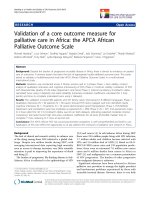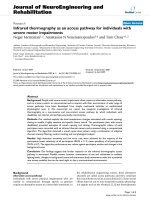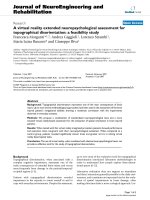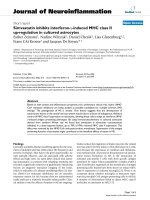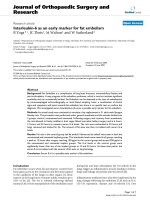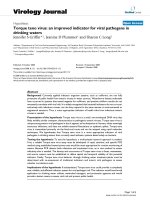Báo cáo hóa học: " Torque teno virus: an improved indicator for viral pathogens in drinking waters" pot
Bạn đang xem bản rút gọn của tài liệu. Xem và tải ngay bản đầy đủ của tài liệu tại đây (271.85 KB, 6 trang )
BioMed Central
Page 1 of 6
(page number not for citation purposes)
Virology Journal
Open Access
Hypothesis
Torque teno virus: an improved indicator for viral pathogens in
drinking waters
Jennifer S Griffin*
1
, Jeanine D Plummer
1
and Sharon C Long
2
Address:
1
Department of Civil and Environmental Engineering, 100 Institute Road, Worcester Polytechnic Institute, Worcester, MA 01609, USA
and
2
Department of Soil Science and Wisconsin State Laboratory of Hygiene, 2601 Agriculture Drive, Madison, WI 53718, USA
Email: Jennifer S Griffin* - ; Jeanine D Plummer - ; Sharon C Long -
* Corresponding author
Abstract
Background: Currently applied indicator organism systems, such as coliforms, are not fully
protective of public health from enteric viruses in water sources. Waterborne disease outbreaks
have occurred in systems that tested negative for coliforms, and positive coliform results do not
necessarily correlate with viral risk. It is widely recognized that bacterial indicators do not co-occur
exclusively with infectious viruses, nor do they respond in the same manner to environmental or
engineered stressors. Thus, a more appropriate indicator of health risks from infectious enteric
viruses is needed.
Presentation of the hypothesis: Torque teno virus is a small, non-enveloped DNA virus that
likely exhibits similar transport characteristics to pathogenic enteric viruses. Torque teno virus is
unique among enteric viral pathogens in that it appears to be ubiquitous in humans, elicits seemingly
innocuous infections, and does not exhibit seasonal fluctuations or epidemic spikes. Torque teno
virus is transmitted primarily via the fecal-oral route and can be assayed using rapid molecular
techniques. We hypothesize that Torque teno virus is a more appropriate indicator of viral
pathogens in drinking waters than currently used indicator systems based solely on bacteria.
Testing the hypothesis: To test the hypothesis, a multi-phased research approach is needed.
First, a reliable Torque teno virus assay must be developed. A rapid, sensitive, and specific PCR
method using established nested primer sets would be most appropriate for routine monitoring of
waters. Because PCR detects both infectious and inactivated virus, an in vitro method to assess
infectivity also is needed. The density and occurrence of Torque teno virus in feces, wastewater,
and source waters must be established to define spatial and temporal stability of this potential
indicator. Finally, Torque teno virus behavior through drinking water treatment plants must be
determined with co-assessment of traditional indicators and enteric viral pathogens to assess
whether correlations exist.
Implications of the hypothesis: If substantiated, Torque teno virus could provide a completely
new, reliable, and efficient indicator system for viral pathogen risk. This indicator would have broad
application to drinking water utilities, watershed managers, and protection agencies and would
provide a better means to assess viral risk and protect public health.
Published: 3 October 2008
Virology Journal 2008, 5:112 doi:10.1186/1743-422X-5-112
Received: 15 September 2008
Accepted: 3 October 2008
This article is available from: />© 2008 Griffin et al; licensee BioMed Central Ltd.
This is an Open Access article distributed under the terms of the Creative Commons Attribution License ( />),
which permits unrestricted use, distribution, and reproduction in any medium, provided the original work is properly cited.
Virology Journal 2008, 5:112 />Page 2 of 6
(page number not for citation purposes)
Background
The connection between fecal contamination of drinking
water and outbreaks of disease from waterborne patho-
gens has been established for more than a century [1].
Because it would not be feasible to monitor directly for
every known pathogen, indicator organisms, which corre-
late with fecal contamination and suggest health risk, are
used instead [2,3]. In water supply systems, monitoring
for total coliforms, fecal coliforms, and E. coli is regulated
under the Total Coliform Rule (TCR) [4]. However, these
bacterial indicators are not always 100% protective of
public health, particularly from enteric viruses. Water-
borne disease outbreaks of viral etiology have occurred in
systems in which coliforms were absent, and instances of
coliform presence in violation of the TCR are not always
associated with adverse public health outcomes [5-7].
The use of coliforms as indicators of viral pathogen risk is
problematic for several reasons:
1) There is a lack of association between coliforms and
human enteric viruses in the environment. Bacterial indi-
cators have low predictive ability for enteric viruses [8,9]
and low or no correlation to viruses [10-16].
2) The fate of coliforms and viral pathogens in environ-
mental systems is disparate. Coliform bacteria are more
susceptible than enteric viruses to extremes in pH, salin-
ity, and temperature [9,17-19]. In addition, bacteria are
more easily removed by filtration through natural aquifer
systems [13,20-22]. Overall, virus persistence and mobil-
ity generally exceed that of bacteria in environmental
waters [9,23].
3) Coliforms and viral pathogens have distinct resistance
patterns in engineered treatment processes [24]24, and
infectious viruses have been found in finished waters that
are coliform negative [25,26]. Physical removal of viruses
through treatment systems, for instance by ultrafiltration
or microfiltration membranes, is more challenging than
removal of bacteria [27-32]. In addition, many enteric
viruses are more resistant than bacteria to disinfection
with chlorine and ultraviolet radiation [8,33-36].
Several alternatives to bacterial indicators have been pro-
posed. Coliphages exhibit similarities to enteric viruses
regarding environmental transport and survival [37,38].
However, coliphage survival characteristics vary by season
[39] and by coliphage group [12,40-43]. In addition, col-
iphages may continue to replicate in surviving bacterial
hosts after being shed in feces, thus exhibiting much
greater persistence than human enteric viruses in receiving
waters [9,44]. Alternatively, only a small percentage of
human or animal fecal samples test positive for col-
iphages [45,46] so these viruses may be too sparse to
detect in some environmental waters.
Some researchers have suggested enteroviruses or norovi-
ruses as indicators of other enteric viruses [47,48]. How-
ever, these viruses exhibit seasonal fluctuations and
epidemic spikes [16,49]. In addition, quantification of
infectious noroviruses in vitro has only recently been
accomplished using 3-D cell culture [50], which is well
beyond the analytical capabilities of typical water testing
laboratories. Adenovirus has been proposed as an indica-
tor because of its remarkable resistance characteristics and
lack of seasonal variability. However, this virus did not
correlate with hepatitis A virus or enteroviruses in urban
waterways [51].
We hypothesize that Torque teno virus (TTV) is a superior
indicator of enteric viruses compared to traditional bacte-
rial indicators and proposed viral indicators. TTV is an
enterically transmitted human virus, but it exhibits char-
acteristics that distinguish it from other enteric viruses.
Recent studies toward understanding the biology and
occurrence of TTV provide preliminary support for our
hypothesis.
Presentation of the hypothesis
TTV is a recently discovered non-enveloped virus with a
single-stranded, circular DNA genome [52-54]. TTV iso-
lates are remarkably variable with 47–70% divergence at
the amino acid level [55,56]. TTV divergence is unevenly
distributed across the genome; hypervariable regions exist
within the coding region [57], and the untranslated region
contains conserved regulatory sequences [58].
Initially, TTV was described as a novel hepatitis virus [52],
but it was later determined that TTV circulates in a large
proportion of healthy individuals [59-61] with an average
worldwide prevalence estimated at 80% [62,63]. The virus
appears to elicit both persistent and transient infections
[52]. Transmission of TTV is primarily by the fecal-oral
route [63], but it is detected in a variety of human tissues
and fluids, including plasma and serum [64-68]. Many
attempts have been made to assign a pathology to TTV,
but none have been substantiated. In fact, Griffiths [69]
and Simmonds et al. [70] have suggested that TTV may
constitute the first known commensal human virus.
A few investigators have tracked TTV in the environment
or in treatment systems. Their results suggest that TTV may
co-locate with various enteric viruses. Currently, little is
known about the environmental stability of TTV,
although Takayama et al. [71] demonstrated that TTV
infectivity was not lost after 95 hours of dry heat treat-
ment. Investigators suspect that TTV particles are highly
resistant to environmental stressors [72].
Virology Journal 2008, 5:112 />Page 3 of 6
(page number not for citation purposes)
In polluted streams of Brazil, TTV was found to be spa-
tially and temporally constant [61], and the TTV positivity
rate of 92.3% paralleled the positivity rate reported by de
Paula et al. [73] for hepatitis A virus in the same geo-
graphic region. In Italy, river water samples receiving
waste treatment effluent were found to contain TTV and
other enteric viruses [72]. TTV and rotavirus occurred
either simultaneously or within 1 month's sampling
period of each other. In addition, TTV occurred 1–2
months after enterovirus was detected and simultane-
ously or within 2 months of noroviruses g1 and g2 in all
but one case.
Vaidya et al. [59] compared sewage treatment plant influ-
ent and effluent concentrations of TTV and hepatitis A and
E viruses via PCR and observed that raw sewage preva-
lence of TTV DNA was statistically similar to the preva-
lence of hepatitis E virus RNA and hepatitis A virus RNA.
Following treatment, hepatitis A virus RNA was signifi-
cantly reduced, but the reductions in TTV and hepatitis E
virus genetic material were not statistically significant.
When TTV was monitored through activated sludge waste-
water treatment plants in Japan, researchers reported that
the TTV genome was detected with 97% frequency in
influent, 18% in secondary effluent after activated sludge
but before chlorination, 24% in final effluent after chlo-
rination, and 0% in effluent for reuse following filtration
and ozonation [60]. In contrast, coliforms decreased
sequentially with each step in the treatment process, and
the concentration of coliforms did not correlate with the
number of positive TTV samples collected at any step.
As a putative indicator, TTV should be abundant where
water is not adequately treated and diarrheal disease is
common and should exist at low or undetectable levels
where water treatment leads to clean, potable water. Poor
sanitation may increase TTV transmission by the fecal-oral
route, as the countries of Bolivia and Burma – both with
high risks of waterborne disease – have TTV incidences of
82% and 96%, respectively, among otherwise healthy
individuals [74]. In contrast, TTV prevalence in the United
States is estimated to be 10% [75]. It is hypothesized that
at this prevalence, TTV would be present in most environ-
mental samples at levels high enough to be detected using
PCR [63] with the exception of contamination resulting
from single septic systems.
Testing the hypothesis
A three-phased plan of research is necessary to determine
the value of TTV as an indicator for viral pathogens.
Phase I – Develop reliable TTV assay
PCR indicates the presence/absence of a target sequence
and would yield a positive result for a non-infectious viral
particle if the particle's genetic material was intact. The
presence of viral nucleic acid at a site nevertheless indi-
cates that contamination occurred in the recent past and
suggests that the site is susceptible to future contamina-
tion [76]. The rapid nature of PCR makes it an ideal tool
for periodic monitoring of water sources.
Because viruses are present in low concentrations in envi-
ronmental waters, it is necessary to concentrate water
samples by several orders of magnitude prior to PCR anal-
ysis. However, sample concentration also may concen-
trate inhibitors of DNA polymerase. The use of hollow
fiber ultrafiltration is proposed. This method is effective
for concentrating MS2 coliphage, noroviruses, and adeno-
viruses for subsequent enumeration or PCR detection
[[77]; Sibley SD, personal communication]. The selection
of primers against conserved regions of the TTV genome is
crucial for accurately detecting all TTV isolates. In addition
to amplifying a conserved sequence, nested or seminested
PCR is proposed; this technique approaches a resolution
of one TTV genome/sample [53,62,78].
If TTV is to be used as an indicator – particularly in a treat-
ment system in which viral particles may be inactivated
but not removed – a method must be available to deter-
mine TTV infectivity. In vitro infection by TTV has been
demonstrated in activated peripheral blood mononuclear
cells and the Chang liver cell line [79-81]. Either of these
may be candidates for infectivity assessment. Chang liver
cells exhibit cytopathic effects 2–3 days after inoculation
with TTV [81] so this cell line may be useful for rapid iden-
tification of infectivity.
Phase II – Monitor TTV in sources
In order to determine the utility of TTV as an indicator, the
occurrence, density, and persistence of TTV in feces, waste-
water, and environmental waters need to be evaluated.
Geographically diverse samples should be collected dur-
ing all seasons to assess both spatial and temporal stabil-
ity. The persistence of the TTV genome has not been
described in environmental waters, but researchers have
reported that TTV DNA from fecal extracts degrades by
approximately 3 log
10
within 1 week when monitored by
real-time PCR at 37°C [81]. Once these data are gathered,
the results can be compared to coliforms, coliphages, and
total culturable viruses to determine whether TTV co-
locates with other enteric viruses and/or other indicators.
Phase III – Monitor TTV through drinking water treatment
The fate of TTV through drinking water treatment proc-
esses needs to be assessed. Prior research has demon-
strated removal/inactivation of TTV through wastewater
treatment [60], but data are lacking for municipal drink-
ing waters. As with source monitoring, spatial and tempo-
ral diversity of the sampling protocol is necessary. Co-
monitoring coliforms, coliphages, and total culturable
Virology Journal 2008, 5:112 />Page 4 of 6
(page number not for citation purposes)
viruses should be performed to demonstrate the relative
resistance of TTV to treatment effects and to determine
relationships, if any, among TTV, enteric viruses, and indi-
cators.
Implications of the hypothesis
Because of the shortcomings of traditional bacterial indi-
cator organisms to accurately indicate viral risk, novel
indicator or monitoring systems are needed. If the indica-
tor potential of TTV is substantiated, a TTV indicator sys-
tem could complement or replace traditional bacterial
indicators for the detection of human enteric viruses in
environmental samples. The ability to assess viral patho-
gen risk would be enhanced, and ultimately, public health
would be better protected.
Competing interests
The authors declare that they have no competing interests.
Authors' contributions
All authors contributed equally to this manuscript. All
authors read and approved the final manuscript.
Authors' information
JSG is a graduate student at WPI with expertise in molecu-
lar, biochemical, and virologic techniques. JSG is well
versed in PCR, including real-time and endpoint PCR. Her
technical skills include mammalian, yeast, and bacterial
cell culture; genetic engineering; viral protein biochemis-
try; and basic viral infection, propagation, and storage
techniques. JDP is a faculty member in Environmental
Engineering with 15 years experience in source water pro-
tection, microbial source tracking, and physical/chemical
water treatment. SCL is a faculty member in Soil Science
and Director of Microbiology at a State Hygiene Labora-
tory. She has over 20 years of expertise in watershed man-
agement, water quality analysis, indicator organism
microbiology and public health issues.
Acknowledgements
This material is based upon work supported under a National Science
Foundation Graduate Research Fellowship.
References
1. Snow J: On the mode of communication of cholera 2nd edition. London:
J. Churchill; 1855.
2. Toranzos GA, McFeters GA: Detection of indicator microorgan-
isms in environmental freshwaters and drinking waters. In
Manual of Environmental Microbiology Edited by: Hurst CJ, Knudsen GR,
McInerney MJ, Stetzenbach LD, Walter M. Washington, DC: Ameri-
can Society for Microbiology Press; 1997:184-194.
3. National Research Council: Indicators for waterborne pathogens Wash-
ington, DC: National Academy Press; 2004.
4. U.S. Environmental Protection Agency: National Primary Drink-
ing Water Regulations: Total Coliform Rule, Final Rule. Fed-
eral Register 1989, 54:27544-27568.
5. D'Antonio RG, Winn RE, Taylor JP, Gustafson TL, Current WL,
Rhodes MM, Gary GW Jr, Zalac RA: A waterborne outbreak of
cryptosporidiosis in normal hosts. Ann Int Med 1985,
103:886-888.
6. Craun GF, Berger PS, Calderon RL: Coliform bacteria and water-
borne disease outbreaks. JAWWA 1997, 89:96-104.
7. Hrudey SE, Hrudey EJ: Safe Drinking Water: Lessons from Recent Out-
breaks in Affluent Nations London: IWA Publishing; 2004.
8. Bosch A, Lucena F, Diez JM, Gajardo R, Blasi M, Jofre J: Waterborne
viruses associated with hepatitis outbreak. JAWWA 1991,
83:80-83.
9. Nasser AM, Oman SD: Quantitative assessment of the inactiva-
tion of pathogenic and indicator viruses in natural water
sources. Water Res 1999, 33:1748-1752.
10. Gerba CP, Goyal SM, LaBelle RL, Cech I, Bogdan GF: Failure of indi-
cator bacteria to reflect occurrence of enteroviruses in
marine waters. Am J Pub Health 1979, 69:1116-1119.
11. LaBelle RL, Gerba CP, Goyal SM, Melnick JL, Cech I, Bogdan GF:
Relationships between environmental factors, bacterial indi-
cators, and the occurrence of enteric viruses in estuarine
sediments. Appl Environ Microbiol 1980, 39(3):586-596.
12. Nasser AM, Tchorch Y, Fattal B: Comparative survival of E. coli,
F+ bacteriophages, HAV and poliovirus 1 in wastewater and
groundwater. Water Sci Technol 1993, 27:401-407.
13. Scandura JE, Sobsey MD: Viral and bacterial contamination of
groundwater from on-site sewage treatment systems.
Water
Sci Technol 1997, 35:141-146.
14. Borchardt M, Haas NL, Hunt RJ: Vulnerability of drinking-water
wells in La Crosse, Wisconsin, to enteric-virus contamina-
tion from surface water contributions. Appl Environ Microbiol
2004, 70:5937-5946.
15. Jiang SC, Chu W: PCR detection of pathogenic viruses in south-
ern California urban rivers. J Appl Microbiol 2004, 97:17-28.
16. Skraber S, Gassilloud B, Gantzer C: Comparison of coliforms and
coliphages as tools for assessment of viral contamination in
river water. Appl Environ Microbiol 2004, 70:3644-3649.
17. Springthorpe VS, Loh CL, Robertson WJ, Sattar SA: In situ survival
of indicator bacteria, MS-2 phage and human pathogenic
viruses in river water. Water Sci Technol 1993, 27:413-420.
18. Bosch A: Human enteric viruses in the water environment: a
minireview. Int Microbiol 1998, 1:191-196.
19. Fong TT, Lipp EK: Enteric viruses of humans and animals in
aquatic environments: health risks, detection, and potential
water quality assessment tools. Microbiol Mol Biol Rev 2005,
69:357-371.
20. Macler BA, Merkle JC: Current knowledge on groundwater
microbial pathogens. Hydrol J 2000, 8:29-40.
21. Azadpour-Keeley A, Faulkner BR, Chen JS: Movement and longev-
ity of viruses in the subsurface. EPA Ground Water Issue
2003:1-24.
22. Reynolds KA, Mena KD, Gerba CP: Risk of waterborne illness via
drinking water in the United States. Rev Environ Contam Toxicol
2008, 192:117-158.
23. Bitton G, Farrah SR, Ruskin RH, Butner J, Chou YJ: Survival of path-
ogenic and indicator organisms in groundwater. Ground Water
1983, 21:405.
24. Payment P, Armon R: Virus removal by drinking water treat-
ment processes. CRC Crit Rev Environ Contr 1989, 19:
15-31.
25. Keswick BH, Gerba CP, DuPont HL, Rose JB: Detection of enteric
viruses in treated drinking water. Appl Environ Microbiol 1984,
47:1290-1294.
26. Payment P, Trudel M, Plante R: Elimination of viruses and indica-
tor bacteria at each step of treatment during preparation of
drinking water at seven water treatment plants. Appl Environ
Microbiol 1985, 49:1418-1428.
27. Jacangelo JG, Laine JM, Carns KE, Cummings EW, Mallevaille J: Low-
pressure membrane filtration for removing Giardia and
microbial indicators. JAWWA 1991, 83:97-106.
28. Jacangelo JG, Adham SS, Laine JM: Mechanism of Cryptosporid-
ium, Giardia, and MS2 virus removal by MF and UF. JAWWA
1995, 87:107.
29. Nasser A, Weinberg D, Dinoor N, Fattal B, Adin A: Removal of
hepatitis virus (HAV), poliovirus and MS2 coliphage by coag-
ulation and high rate filtration. Water Sci Technol 1995, 31:63-68.
30. Yoo S, Brown DR, Pardini RJ, Bentson GD: Microfiltration: a case
study. JAWWA 1995, 87:38-49.
31. Hagen K: Removal of particles, bacteria and parasites with
ultrafiltration for drinking water treatment. Desalination 1998,
119:85-91.
Virology Journal 2008, 5:112 />Page 5 of 6
(page number not for citation purposes)
32. Harrington GW, Xagoraraki I, Assavasilavasukul P, Standridge JH:
Effect of filtration conditions on removal of emerging water-
borne pathogens. JAWWA 2003, 95:95-104.
33. Melnick JL, Gerba CP, Wallis C: Viruses in water. Bull World Health
Organ 1978, 56:499-508.
34. Keswick BH, Satterwhite TK, Johnson PC, DuPont HL, Secor SL, Bit-
sura JA, Gary GW, Hoff JC: Inactivation of Norwalk virus in
drinking water by chlorine. Appl Environ Microbiol 1985,
50:261-264.
35. Chang JCH, Ossoff SF, Lobe DC, Dorfman MH, Dumais CM, Qualls
RG, Johnson JD: UV inactivation of pathogenic and indicator
organisms. Appl Environ Microbiol 1985, 49:1361-1365.
36. Gerba CP, Gramos DM, Nwachuku N: Comparative inactivation
of enteroviruses and adenovirus 2 by UV light. Appl Environ
Microbiol 2002, 68:5167-5169.
37. Osawa S, Furuse K, Watanabe I: Distribution of ribonucleic acid
coliphages in animals. Appl Environ Microbiol 1981, 41:164-168.
38. Furuse K: Distribution of coliphages in the environment: gen-
eral considerations. In Phage Ecology Edited by: Goyal SM, Gerba
CP, Bitton G. New York: Wiley-Interscience; 1987:87-123.
39. Chung H, Sobsey MD: Comparative survival of indicator viruses
and enteric viruses in seawater and sediment. Water Sci Tech-
nol 1993, 27:425-428.
40. San Martin C, Burnett RM, de Haas F, Heinkel R, Rutten T, Fuller SD,
Butcher SJ, Bamford DH: Combined EM/X-ray imaging yields a
quasi-atomic model of the adenovirus-related bacteriophage
PRD1 and shows key capsid and membrane interactions.
Structure 2001, 9:917-930.
41. U.S. Environmental Protection Agency: Method 1601: male-spe-
cific (F+) and somatic coliphage in water by two-step enrich-
ment procedure. In EPA 821-R-01-030 Office of Water,
Washington, DC; 2001.
42. U.S. Environmental Protection Agency: Method 1602: Male-spe-
cific (F+) and somatic coliphage in water by single agar layer
procedure. In EPA 821-R-01-029 Office of Water, Washington, DC;
2001.
43. Long SC, Sobsey MD: A comparison of the survival of F+RNA
and F+DNA coliphages in lake water microcosms. J Water
Health 2004, 2:15-22.
44. Pang L, Close M, Goltz M, Sinton L, Davies H, Hall C, Stanton G: Esti-
mation of septic tank setback distances based on transport
of E. coli and F-RNA phages. Environ Int 2004, 29:907-921.
45. Long SC, Mahar EJ, Pei R, Arango C, Shafer E, Schoenberg TH: Devel-
opment of source-specific indicator organisms for drinking
water. In Technical Report American Water Works Association
Research Foundation, Denver, CO; 2002.
46. Long SC, El-Khoury SS, Oudejans S, Sobsey MD, Vinje J: Assessment
of sources and diversity of male-specific coliphages for
source tracking. Environ Eng Sci 2005, 22:367-377.
47. Kopecka H, Dubrou S, Prevot J, Marechal J, Lopez-Pila JM: Detection
of naturally occurring enteroviruses in waters by reverse
transcription, polymerase chain reaction, and hybridization.
Appl Environ Microbiol 1993, 59:1213-1219.
48. Metcalf TG, Melnick JL, Estes MK: Environmental virology: from
detection of virus in sewage and water by isolation to identi-
fication by molecular biology – a trip of over 50 years. Annu
Rev Microbiol 1995, 49:461-487.
49. Haramoto E, Katayama H, Oguma K, Yamashita H, Tajima A, Naka-
jima H, Ohgaki S: Seasonal profiles of human noroviruses and
indicator bacteria in a wastewater treatment plant in Tokyo,
Japan. Water Sci Technol 2006, 54:301-308.
50. Straub TM, Bentrup KH, Orosz-Coghlan P, Dohnalkova A, Mayer BK,
Bartholomew RA, Valdez CO, Bruckner-Lea CJ, Gerba CP, Abbasza-
degan M, Nickerson CA: In vitro cell culture infectivity assay for
human noroviruses. Emerg Infect Dis 2007, 13:396-403.
51. Jiang SC: Adenovirus as an index of human viral contamina-
tion. U.S. EPA Workshop on Microbial Source Tracking: 5 February 2002;
Irvine 2002:75-78.
52. Nishizawa T, Okamoto H, Konishi K, Yoshizawa H, Miyakawa Y,
Mayumi M: A novel DNA virus (TTV) associated with elevated
transaminase levels in posttransfusion hepatitis of unknown
etiology. Biochem Biophys Res Commun 1997, 241:92-97.
53. Okamoto H, Nishizawa T, Kato N, Ukita M, Ikeda H, Iizuka H, Miya-
kawa Y, Mayumi M: Molecular cloning and characterization of
a novel DNA virus (TTV) associated with posttransfusion
hepatitis of unknown etiology. Hepatol Res 1998, 10:1-16.
54. Miyata H, Tsunoda H, Kazi A, Yamada A, Khan MA, Murakami J,
Kamahora T, Shiraki K, Hino S: Identification of a novel GC-rich
113-nucleotide region to complete the circular, single-
stranded DNA genome of TT virus, the first human circovi-
rus. J Virol 1999, 73:3582-3586.
55. Biagini P, Gallian P, Attoui H, Cantaloube JF, de Micco P, de Lam-
ballerie X: Determination and phylogenetic analysis of partial
sequences from TT virus isolates. J Gen Virol 1999, 80:419-424.
56. Luo K, He H, Liu Z, Liu D, Xiao H, Jiang X, Liang W, Zhang L: Novel
variants related to TT virus distributed widely in China. J
Med Virol 2002, 67:118-126.
57. Nishizawa T, Okamoto H, Tsuda F, Aikawa T, Sugai Y, Konishi K, Aka-
hane Y, Ukita M, Tanaka T, Miyakawa T, Mayumi M: Quasispecies of
TT virus (TTV) with sequence divergence in hypervariable
regions of the capsid protein in chronic TTV infection. J Virol
1999, 73:9604-9608.
58. Leary TP, Erker JC, Chalmers ML, Desai SM, Mushahwar IK:
Improved detection systems for TT virus reveal high preva-
lence in humans, non-human primates and farm animals. J
Gen Virol 1999, 80:2115-2120.
59. Vaidya SR, Chitambar SD, Arankalle VA: Polymerase chain reac-
tion-based prevalence of hepatitis A, hepatitis E and TT
viruses in sewage from an endemic area. J Hepatol 2002,
37:131-136.
60. Haramoto E, Katayama H, Oguma K, Yamashita H, Nakajima E,
Ohgaki S: One-year monthly monitoring of Torque teno virus
(TTV) in wastewater treatment plants in Japan. Water Res
2005, 39:2008-2013.
61. Diniz-Mendes L, de Paula VS, Luz SLB, Niel C: High prevalence of
human Torque teno virus in streams crossing the city of
Manaus, Brazilian Amazon. J Appl Microbiol 2008, 105:51-58.
62. Springfeld C, Bugert JJ, Schnitzler P, Tobiasch E, Kehm R, Darai G: TT
virus as a human pathogen: significance and problems. Virus
Genes 2000,
20:35-45.
63. Bendinelli M, Pistello M, Maggi F, Fornai C, Freer G, Vatteroni L:
Molecular properties, biology, and clinical implications of TT
virus, a recently identified widespread infectious agent of
humans. Clin Microbiol Rev 2001, 14:98-113.
64. Ross RS, Viazov S, Runde V, Schaefer UW, Roggendorf M: Detection
of TT virus DNA in specimens other than blood. J Clin Virol
1999, 13:181-184.
65. Okamoto H, Takahashi M, Nishizawa T, Tawara A, Sugai Y, Sai T, Tan-
aka T, Tsuda F: Replicative forms of TT virus DNA in bone
marrow cells. Biochem Biophys Res Comm 2000, 270:657-662.
66. Okamoto H, Ukita M, Nishizawa T, Kishimoto J, Hoshi Y, Mizuo H,
Tanaka T, Miyakawa Y, Mayumi M: Circular double-stranded
forms of TT virus DNA in the liver. J Virol 2000, 74:5161-5167.
67. Okamoto H, Nishizawa T, Takahashi M, Asabe S, Tsuda F, Yoshikawa
A: Heterogeneous distribution of TT virus of distinct geno-
types in multiple tissues from infected humans. Virology 2001,
288:358-368.
68. Pollicino T, Raffa G, Squadrito G, Costantino L, Cacciola I, Brancatelli
S, Alafaci C, Florio MG, Raimondo G: TT virus has ubiquitous dif-
fusion in human body tissues: analyses of paired serum and
tissue samples. J Viral Hepat 2003, 10:95-102.
69. Griffiths P: Time to consider the concept of a commensal
virus? Rev Med Virol 1999, 9:73-74.
70. Simmonds P, Prescott LE, Logue C, Davidson F, Thomas AE, Ludlam
CA: TT virus – part of the normal human flora? J Infect Dis
1999, 180:1748-1750.
71. Takayama S, Miura T, Matsuo S, Taki M, Sugh S: Prevalence and
persistence of a novel DNA TT virus (TTV) infection in Jap-
anese hemophiliacs. Br J Haematol 1999, 104:626-629.
72. Verani M, Casini B, Battistini R, Pizzi F, Rovini E, Carducci A: One-
year monthly monitoring of Torque teno virus (TTV) in river
water in Italy. Water Sci Technol 2006,
54:191-195.
73. de Paula VS, Diniz-Mendes L, Villar LM, Luz SL, Silva LA, Jesus MS, da
Silva NM, Gaspar AM: Hepatitis A virus in environmental water
samples from the Amazon Basin. Water Res 2007,
41:1169-1176.
74. Abe K, Inami T, Asano K, Miyoshi C, Masaki N, Hayashi S, Ishikawa K-
I, Takebe Y, Win KM, El-Zayadi AR, Han K-H, Zhang DY: TT virus
infection is widespread in the general populations from dif-
ferent geographic regions. J Clin Microbiol 1999, 37:2703-2705.
75. Desai SM, Muerhoff AS, Leary TP, Erker JC, Simons JN, Chalmers ML,
Birkenmeyer LG, Pilot-Matias TJ, Mushahwar IK: Prevalence of TT
Publish with BioMed Central and every
scientist can read your work free of charge
"BioMed Central will be the most significant development for
disseminating the results of biomedical researc h in our lifetime."
Sir Paul Nurse, Cancer Research UK
Your research papers will be:
available free of charge to the entire biomedical community
peer reviewed and published immediately upon acceptance
cited in PubMed and archived on PubMed Central
yours — you keep the copyright
Submit your manuscript here:
/>BioMedcentral
Virology Journal 2008, 5:112 />Page 6 of 6
(page number not for citation purposes)
virus infection in US blood donors and populations at risk for
acquiring parenterally transmitted viruses. J Infect Dis 1999,
179:1242-1244.
76. Yates MV: Classical indicators in the 21st century – far and
beyond the coliform. Water Environ Res 2007, 79:279-286.
77. Hill VR, Kahler AM, Jothikumar N, Johnson TB, Hahn D, Cromeans
TL: Multistate evaluation of an ultrafiltration-based proce-
dure for simultaneous recovery of enteric microbes in 100-
liter tap water samples. Appl Environ Microbiol 2007,
73(13):4218-4225.
78. Okamoto H, Akahane Y, Ukita M, Fukuda M, Tsuda F, Miyakawa Y,
Mayumi M: Fecal excretion of an nonenveloped DNA virus
(TTV) associated with posttransfusion non-A-G hepatitis. J
Med Virol 1998, 56:128-132.
79. Maggi F, Fornai C, Zaccaro L, Morrica A, Vatteroni ML, Isola P, Marchi
S, Ricchiuti A, Pistello M, Bendenelli M: TT virus (TTV) loads asso-
ciated with different peripheral blood cell types and evidence
for TTV replication in activated mononuclear cells. J Med Virol
2001, 64:190-194.
80. Mariscal LF, Lopez-Alcorocho JM, Rodriguez-Inigo E, Ortiz-Movilla N,
de Lucas S, Bartolome J, Carreno V: TT virus replicates in stimu-
lated by not in nonstimulated peripheral blood mononuclear
cells. Virology 2002, 301:121-129.
81. Desai M, Pal R, Deshmukh R, Banker D: Replication of TT virus in
hepatocyte and leucocyte cell lines. J Med Virol 2005,
77:136-143.
